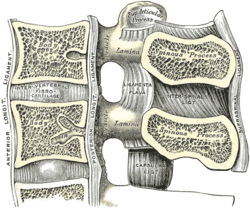Interspinal ligament
| Interspinal ligament | |
|---|---|
 Median sagittal section of two lumbar vertebrae and their ligaments (interspinal ligament visible at center right) | |
| Details | |
| Latin | Ligamenta interspinalia |
| From | Spinous process of vertebra |
| To | Spinous process of vertebra |
| Identifiers | |
| Gray's | p.291 |
| Dorlands /Elsevier | l_09/12492445 |
| TA | A03.2.01.002 |
| FMA | 71392 |
| Anatomical terminology | |
The interspinal ligaments (interspinous ligaments) are thin and membranous ligaments, that connect adjoining spinous processes of the vertebra in the spine.[1][2][3] They extend from the root to the apex of each spinous process. They meet the ligamenta flava in front and blend with the supraspinal ligament behind.[2]
The ligaments are narrow and elongated in the thoracic region, broader, thicker, and quadrilateral in form in the lumbar region, and only slightly developed in the neck.[1] In the neck they are often considered part of the nuchal ligament.[2]
The function of the interspinal ligaments is to limit flexion of the spine.[2]
See also
References
This article incorporates text in the public domain from the 20th edition of Gray's Anatomy (1918)
- ↑ 1.0 1.1 "Gray, Henry. 1918. Anatomy of the Human Body". Bartleby.com. Retrieved 30 March 2013.
- ↑ 2.0 2.1 2.2 2.3 "Interspinous ligaments". AnatomyExpert. Retrieved 30 March 2013.
- ↑ "interspinal ligament". Merriam-Webster. Retrieved 30 March 2013.
External links
Interspinous ligaments on AnatomyExpert.com
| ||||||||||||||||||||||||||||||||||||||||||||||||||||||||||||||||||||||||||||||||||||||||||||